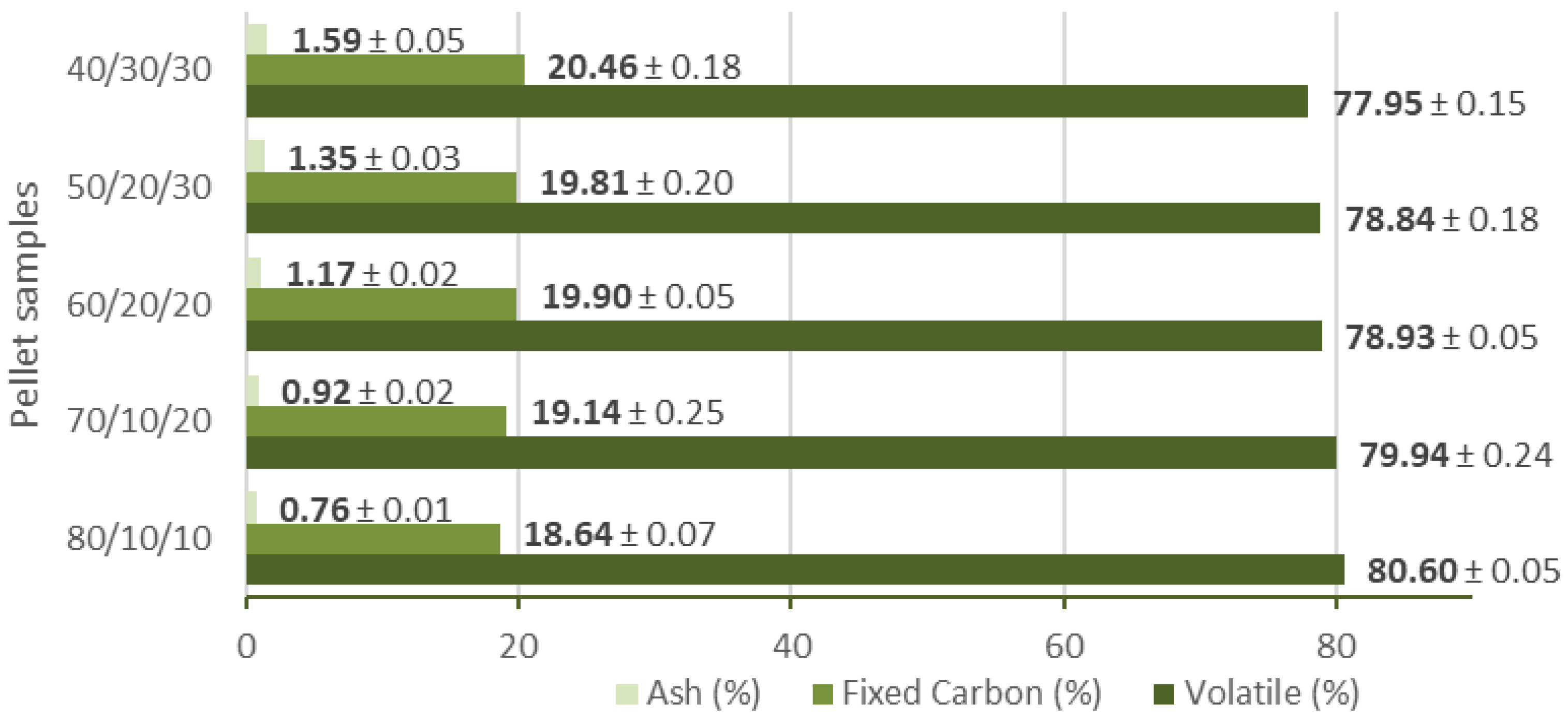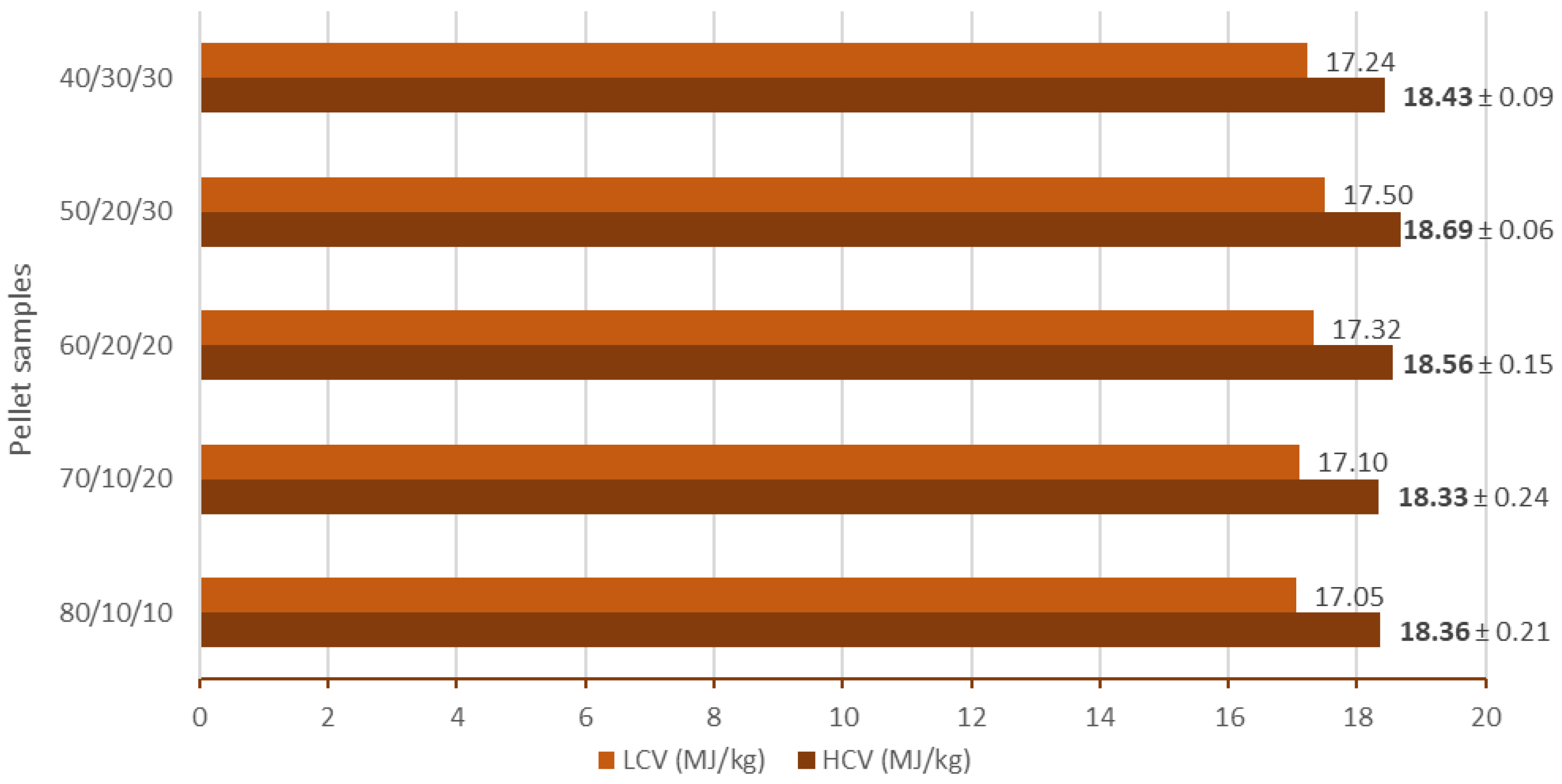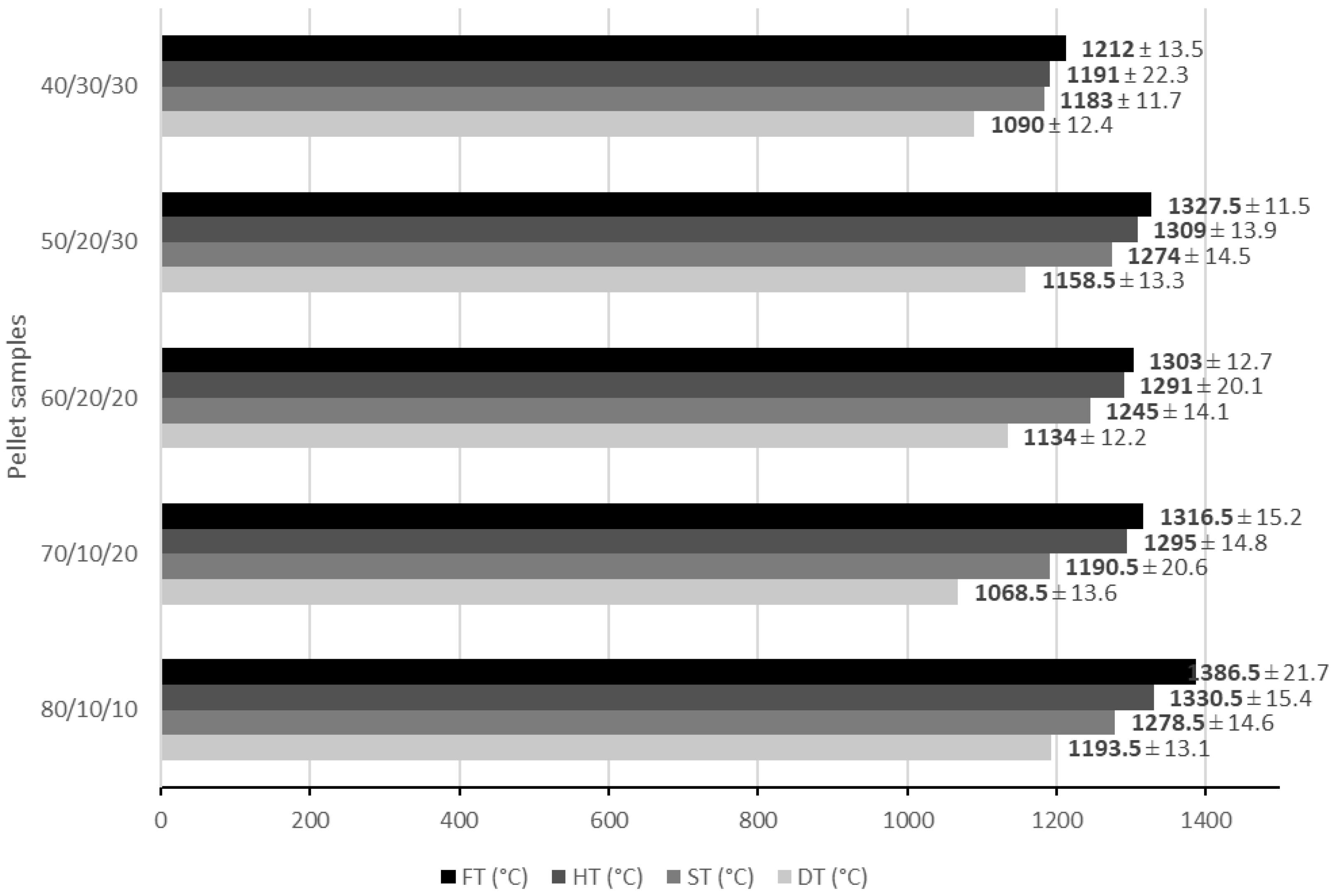Analyses of Pellets Produced from Spruce Sawdust, Spruce Bark, and Pine Cones in Different Proportions
Abstract
:1. Introduction
2. Materials and Methods
2.1. Elemental Analysis
2.2. TGA Analysis
2.3. Calorific Values Analysis
2.4. Ash Melting Temperature Analysis
2.5. Pelletization
2.6. Standard Deviation
3. Results and Discussion
3.1. Elemental Results
3.2. TGA Results
3.3. Calorific Value Results
3.4. Ash Melting Temperature Results
4. Conclusions
Author Contributions
Funding
Institutional Review Board Statement
Informed Consent Statement
Data Availability Statement
Conflicts of Interest
References
- Picchio, R.; Latterini, F.; Venanzi, R.; Stefanoni, W.; Suardi, A.; Tocci, D.; Pari, L. Pellet production from woody and non-woody feedstocks: A review on biomass quality evaluation. Energies 2020, 13, 2937. [Google Scholar] [CrossRef]
- Werle, S.; Dudziak, M. Gaseous fuels production from dried sewage sludge via air gasification. Waste Manag. Res. 2014, 32, 601–607. [Google Scholar] [CrossRef] [PubMed]
- Sitek, T.; Pospisil, J.; Polacik, J.; Chylek, R. Thermogravimetric analysis of solid biomass fuels and corresponding emission of fine particles. Energy 2021, 237, 121609. [Google Scholar] [CrossRef]
- Gendek, A.; Aniszewska, M.; Malaťák, J.; Velebil, J. Evaluation of selected physical and mechanical properties of briquettes produced from cones of three coniferous tree species. Biomass Bioenergy 2018, 117, 173–179. [Google Scholar] [CrossRef]
- Nosek, R.; Backa, A.; Ďurčanský, P.; Holubčík, M.; Jandačka, J. Effect of paper sludge and dendromass on properties of phytomass pellets. Appl. Sci. 2021, 11, 65. [Google Scholar] [CrossRef]
- Honus, S.; Pospíšilík, V.; Jursová, S.; Šmída, Z.; Milnár, V.; Dovica, M. Verifying the prediction result reliability using k-ε, Eddy dissipation and discrete transfer models applied on methane combustion using a prototype low-pressure burner. Adv. Sci. Technol. 2017, 11, 252–259. [Google Scholar] [CrossRef]
- Aniszewska, M.; Gendek, A.; Zychowicz, W. Analysis of selected physical properties of conifer cones with relevance to energy production efficiency. Forests 2018, 9, 405. [Google Scholar] [CrossRef] [Green Version]
- Gendek, A. Combustion heat and calorifi c value of the mix of sawdust and cones of common pine (Pinus sylvestris L.). Ann. Wars. Univ. Life Sci. SGGW 2015, 66, 137–144. [Google Scholar]
- Palacka, M.; Vician, P.; Holubčík, M.; Jandačka, J. The energy characteristics of different parts of the tree. Procedia Eng. 2017, 192, 654–658. [Google Scholar] [CrossRef]
- García, R.; Gil, M.V.; Rubiera, F.; Pevida, C. Pelletization of wood and alternative residual biomass blends for producing industrial quality pellets. Fuel 2019, 251, 739–753. [Google Scholar] [CrossRef]
- Holubcik, M.; Jandacka, J.; Palacka, M.; Kantova, N.; Jachniak, E.; Pavlik, P. The impact of bark content in wood pellets on emission production during combustion in small heat source. Communications 2017, 19, 94–100. [Google Scholar] [CrossRef]
- Matúš, M.; Križan, P.; Šooš, L.; Beniak, J. The effect of papermaking sludge as an additive to biomass pellets on the final quality of the fuel. Fuel 2018, 219, 196–204. [Google Scholar] [CrossRef]
- Filbakk, T.; Jirjis, R.; Nurmi, J.; Høibø, O. The effect of bark content on quality parameters of Scots pine (Pinus sylvestris L.) pellets. Biomass Bioenergy 2011, 35, 3342–3349. [Google Scholar] [CrossRef]
- Zhang, B.; Yang, B.; Wu, S.; Guo, W.; Zhang, J.; Wu, Z.; Wang, Z.; Lim, J.C. Effect of torrefaction pretreatment on the fast pyrolysis behavior of biomass: Product distribution and kinetic analysis on spruce-pin-fir sawdust. J. Anal. Appl. Pyrolysis 2021, 158, 105259. [Google Scholar] [CrossRef]
- ISO 17225; 2 Solid Biofuels—Fuel Specifications and Classes—Part 2: Graded Wood Pellets. International Organization for Standardization: Geneva, Switzerland, 2021.
- Bukhanko, N.; Attard, T.; Arshadi, M.; Eriksson, D.; Budarin, V.; Hunt, A.J.; Geladi, P.; Bergsten, U.; Clark, J. Extraction of cones, branches, needles and bark from Norway spruce (Picea abies) by supercritical carbon dioxide and soxhlet extractions techniques. Ind. Crops Prod. 2020, 145, 112096. [Google Scholar] [CrossRef]
- Aniszewska, M.; Gendek, A. Comparison of heat of combustion and calorific value of the cones and wood of selected forest trees species. Leśne Pr. Badaw. 2014, 75, 231–236. [Google Scholar] [CrossRef] [Green Version]
- Wang, L.; Skreiberg, Ø.; Khalil, R.; Li, H. Effect of fuel mixing on melting behavior of spruce wood ash. Energy Procedia 2019, 158, 1342–1347. [Google Scholar] [CrossRef]






| Sample | Weight Proportion of Spruce Sawdust [%] | Weight Proportion of Spruce Bark [%] | Weight Proportion of Pine Cones [%] |
|---|---|---|---|
| 80/10/10 | 80 | 10 | 10 |
| 70/10/20 | 70 | 10 | 20 |
| 60/20/20 | 60 | 20 | 20 |
| 50/20/30 | 50 | 20 | 30 |
| 40/30/30 | 40 | 30 | 30 |
| Sample | The Content of Carbon (%) | SD (%) | The Content of Hydrogen (%) | SD (%) | The Content of Nitrogen (%) | SD (%) |
|---|---|---|---|---|---|---|
| spruce sawdust | 46.14 | 0.20 | 6.29 | 0.10 | 0.05 | 0.00 |
| spruce wood [9] | 48.56 | - | 6.43 | - | 0.04 | - |
| spruce-pin-fir sawdust [14] | 46.20 | - | 6.40 | - | <0.10 | - |
| beech sawdust | 44.66 | 0.11 | 6.23 | 0.02 | 0.00 | 0.00 |
| pine bark | 49.43 | 0.08 | 5.88 | 0.03 | 0.23 | 0.00 |
| spruce bark | 45.83 | 0.33 | 5.88 | 0.06 | 0.35 | 0.08 |
| spruce bark [9] | 49.52 | - | 6.15 | - | 0.7 | - |
| beech bark | 43.44 | 0.20 | 5.91 | 0.08 | 0.67 | 0.03 |
| pine cones | 44.59 | 0.31 | 6.22 | 0.17 | 0.45 | 0.02 |
| spruce cones [9] | 49.60 | - | 6.10 | - | 0.45 | - |
| Sample | The Content of Volatile (%) | SD (%) | The Content of Fixed Carbon (%) | SD (%) | The Content of Ash (%) | SD (%) |
|---|---|---|---|---|---|---|
| spruce sawdust | 82.13 | 0.13 | 17.45 | 0.13 | 0.42 | 0.01 |
| spruce-pin-fir sawdust [14] | 84.55 | - | 15.06 | - | 0.39 | - |
| beech sawdust | 82.09 | 0.14 | 17.17 | 0.10 | 0.73 | 0.07 |
| pine bark | 66.26 | 0.34 | 31.46 | 0.37 | 2.28 | 0.04 |
| spruce bark | 68.17 | 0.08 | 27.62 | 0.08 | 4.22 | 0.05 |
| beech bark | 73.35 | 0.25 | 20.14 | 0.27 | 6.28 | 0.08 |
| pine cones | 79.26 | 0.32 | 20.13 | 0.29 | 0.61 | 0.03 |
| Sample | The Content of Moisture (%) | SD (%) |
|---|---|---|
| spruce sawdust | 7.08 | 0.05 |
| beech sawdust | 7.44 | 0.10 |
| pine bark | 7.98 | 0.12 |
| spruce bark | 7.45 | 0.06 |
| beech bark | 7.05 | 0.07 |
| pine cones | 7.09 | 0.20 |
| pellet sample 80/10/10 | 5.30 | 0.10 |
| pellet sample 70/10/20 | 5.07 | 0.29 |
| pellet sample 60/20/20 | 6.43 | 0.05 |
| pellet sample 50/20/30 | 4.60 | 0.16 |
| pellet sample 40/30/30 | 5.11 | 0.16 |
Publisher’s Note: MDPI stays neutral with regard to jurisdictional claims in published maps and institutional affiliations. |
© 2022 by the authors. Licensee MDPI, Basel, Switzerland. This article is an open access article distributed under the terms and conditions of the Creative Commons Attribution (CC BY) license (https://creativecommons.org/licenses/by/4.0/).
Share and Cite
Čajová Kantová, N.; Holubčík, M.; Čaja, A.; Trnka, J.; Jandačka, J. Analyses of Pellets Produced from Spruce Sawdust, Spruce Bark, and Pine Cones in Different Proportions. Energies 2022, 15, 2725. https://doi.org/10.3390/en15082725
Čajová Kantová N, Holubčík M, Čaja A, Trnka J, Jandačka J. Analyses of Pellets Produced from Spruce Sawdust, Spruce Bark, and Pine Cones in Different Proportions. Energies. 2022; 15(8):2725. https://doi.org/10.3390/en15082725
Chicago/Turabian StyleČajová Kantová, Nikola, Michal Holubčík, Alexander Čaja, Juraj Trnka, and Jozef Jandačka. 2022. "Analyses of Pellets Produced from Spruce Sawdust, Spruce Bark, and Pine Cones in Different Proportions" Energies 15, no. 8: 2725. https://doi.org/10.3390/en15082725
APA StyleČajová Kantová, N., Holubčík, M., Čaja, A., Trnka, J., & Jandačka, J. (2022). Analyses of Pellets Produced from Spruce Sawdust, Spruce Bark, and Pine Cones in Different Proportions. Energies, 15(8), 2725. https://doi.org/10.3390/en15082725








